A positive side effect of coronavirus is that there’s more help around on some farms. There were four sets of hands working on the Desmond farm in Ovens outside Cork city last Monday. Brian and Jerome Desmond were out fencing while Darrara student Tim Forde was helping Brian’s younger brother Tom clean out the calf shed. Tom is in first year economics at UCC but with college closed he’s now at home full time.

Before grazing pic.
With so much help around the team are well on top of the workload. One hundred and twelve of the 125 cows are calved. This is 86% of the herd calved in six weeks, back a bit on the 90% that were calved in six weeks last year. “We were expecting to be a bit shy of the 90% target this spring because we had a lot of repeats last June, but once they went in calf we were happy enough,” Brian says.
The vet was in the yard only once, to deal with a cow that had twins and held on to a cleaning. There were about 10 cases of milk fever since our last update. Brian is putting this down to overfat cows. Indeed, overfat cows and heifers were the cause of some calving difficulties and probably some of the milk fever too.
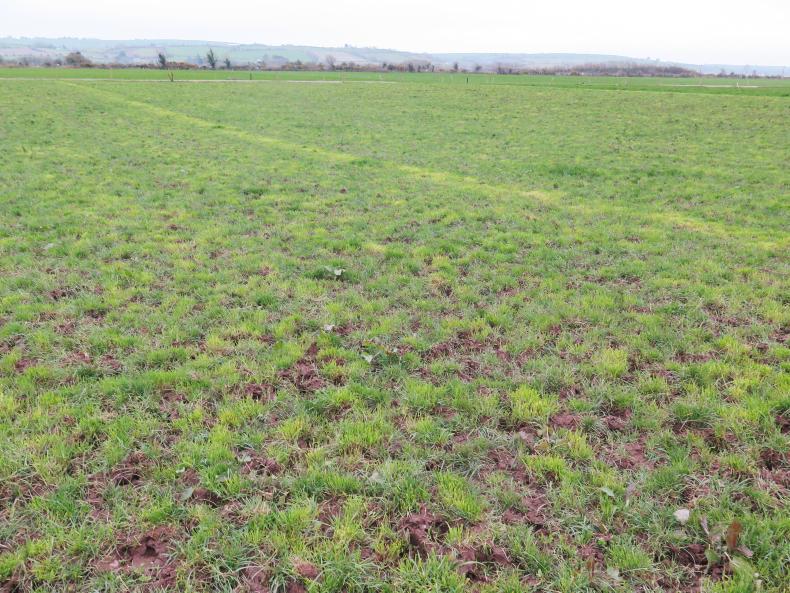
A recently grazed field showing some signs of damage. This field will get 18:6:12
“We put a lot of emphasis into making good-quality silage but it’s probably biting us a bit now as a lot of the dry cows are fat. The silage tested at 78% DMD which is really rocket fuel and too good for dry cows.
“We weighed the maiden heifers the other day and were shocked at the results as they weighed 360kg on average. The range was 311kg to 414kg. They averaged 0.8kg average daily gain between 1 January and now, despite the fact that half of them had no meal since 1 January and the other half got 2kg/day up to 1 February with nothing since.”
The mature cows in the herd weigh 627kg on average. If the target is to be at 60% of mature liveweight at breeding, the maiden heifers should weigh 376kg on 1 May. They are 16kg below this target but in six weeks’ time, presuming they do 1kg/day at grass, they’ll be 26kg over.

After grazing pic: The first field grazed has a cover of 800kgDM/ha back on it already.
The question is, are the maiden heifers very genetically different to their dams, suggesting that the cows shouldn’t be used as a guide to their target weight? Or, are the heifers just too well done? The maintenance sub-index within the EBI is a good indication of size. A high maintenance sub index indicates a smaller cow as that cow is a cheaper animal to maintain itself.
The maintenance sub index of the cows is €11 and the maintenance sub index of the heifers is €9. According to Siobhan Ring of ICBF, every €1 change in maintenance sub index corresponds to a 5kg change in mature liveweight. ?Thus, the €2 difference in maintenance sub index on the Desmond farm is likely to be responsible for 10kg difference in liveweight of the heifers when they are mature. So the actual target liveweight for Brian’s heifers is 382kg, meaning they will still be around 20kg above target weight at breeding.

The herd are out by day and after evening milking, but have been coming in for silage at night.
The thinking for the coming year is to make some dry cow and heifer silage that is low in potash and low in DMD, to be fed pre-calving. Growing this kind of grass will be a culture shock for the Desmonds, who want to maximise grass yields and quality. Brian is looking into the possibility of mixing straw with silage as it’s going into the pit. This would increase the fibre of the silage and lower its quality.
Brian and Jerome are picking AI bulls for the coming season, spurred on by question marks over the availability of semen due to COVID-19. The Crookstown Discussion Group, of which Jerome is a member, has decided to use a minimum of 10% of sexed semen across their herds this season. Brian reckons best results will be achieved in young cows (first and second lactation) and when cows are served in the morning after being observed in heat the evening before. As for the type of bulls they’ll choose, it’ll be all high-EBI black and white with a few Jersey straws to go on cows that are too big for their liking.

Brian Desmond, Ovens, Co Cork.
Grazing
As of Wednesday, Brian has 54% of the farm grazed. The weather has been the biggest challenge this spring. Some damage was done, despite the farm being very dry and that Brian, Jerome and Tim work hard to avoid damage. But, you can’t get land grazed in spring without doing some level of damage. Any damaged paddocks are already recovering well.
There is a cover of 800kg/ha on the first grazed paddock, but this drops off to 400 to 500kg/ha for the next paddocks. Presuming growth rates average 30kg/day over the next 20 days, Brian reckons there’ll be over 1,200kg/ha on the first paddocks in the second rotation by 5 April.
The average farm cover is 1,070kg/ha, which is high, but they’ll want it all. The cows have been coming in for 3kg or 4kg/cow of silage every night. They come in to the shed after going out to grass for three or four hours after evening milking.
“We missed five day grazings in February and about four or five day grazings in March where the cows didn’t go out at all. We would have missed a lot more night grazings though,” Brian says.
The stocking rate on the milking platform is high at about 3.8 cows/ha, so bringing them in for silage at night allows them to ration out the grass. This is a high-yielding herd so dry matter intakes are high. Currently, the herd is being allocated 9kg of grass and 4.5kg of meal on top of the silage, bringing total allowance to around 17kgDM/cow/day.
The cows are milking exceptionally well at 27l/day with constituents of 4.62% fat and 3.25% protein, which is 2.19kgMS/cow/day.
“To be honest I’m a bit disappointed with the protein levels. I’d prefer if they milked a litre or two less but had higher protein,” Brian says.
The herd looked in fabulous order, with a handful of cows at body condition score of 2.75, but most probably closer to 3. An insufficient amount of energy in the diet is unlikely to be a cause of the lower protein percentage. However, to be fair, cows milking almost 2.2kg of milk solids per day in mid-March after an exceptionally wet spring is serious production.
The plan is that by this weekend the cows will stay out all night, weather permitting, and silage will be removed from the diet. How much meal to feed will depend on the grass budget and growth rates along with weather conditions, but it will be within the 4 to 6kg/cow/day range.
In terms of fertiliser, so far half the farm has received 60 units/acre of nitrogen while the other half has received 35 units/acre of nitrogen. Most of the 50% of the farm that has been grazed has received 2,500 gallons/acre of slurry. The plan is to spread 18:6:12 on any parts of the farm that were damaged. Brian says they normally have 70 units/acre of nitrogen out by 1 April, but there will be less spread this year on account of the weather.
Read more
Calving off to a good start in Cork
No stop to grazing in the southeast
A positive side effect of coronavirus is that there’s more help around on some farms. There were four sets of hands working on the Desmond farm in Ovens outside Cork city last Monday. Brian and Jerome Desmond were out fencing while Darrara student Tim Forde was helping Brian’s younger brother Tom clean out the calf shed. Tom is in first year economics at UCC but with college closed he’s now at home full time.

Before grazing pic.
With so much help around the team are well on top of the workload. One hundred and twelve of the 125 cows are calved. This is 86% of the herd calved in six weeks, back a bit on the 90% that were calved in six weeks last year. “We were expecting to be a bit shy of the 90% target this spring because we had a lot of repeats last June, but once they went in calf we were happy enough,” Brian says.
The vet was in the yard only once, to deal with a cow that had twins and held on to a cleaning. There were about 10 cases of milk fever since our last update. Brian is putting this down to overfat cows. Indeed, overfat cows and heifers were the cause of some calving difficulties and probably some of the milk fever too.

A recently grazed field showing some signs of damage. This field will get 18:6:12
“We put a lot of emphasis into making good-quality silage but it’s probably biting us a bit now as a lot of the dry cows are fat. The silage tested at 78% DMD which is really rocket fuel and too good for dry cows.
“We weighed the maiden heifers the other day and were shocked at the results as they weighed 360kg on average. The range was 311kg to 414kg. They averaged 0.8kg average daily gain between 1 January and now, despite the fact that half of them had no meal since 1 January and the other half got 2kg/day up to 1 February with nothing since.”
The mature cows in the herd weigh 627kg on average. If the target is to be at 60% of mature liveweight at breeding, the maiden heifers should weigh 376kg on 1 May. They are 16kg below this target but in six weeks’ time, presuming they do 1kg/day at grass, they’ll be 26kg over.

After grazing pic: The first field grazed has a cover of 800kgDM/ha back on it already.
The question is, are the maiden heifers very genetically different to their dams, suggesting that the cows shouldn’t be used as a guide to their target weight? Or, are the heifers just too well done? The maintenance sub-index within the EBI is a good indication of size. A high maintenance sub index indicates a smaller cow as that cow is a cheaper animal to maintain itself.
The maintenance sub index of the cows is €11 and the maintenance sub index of the heifers is €9. According to Siobhan Ring of ICBF, every €1 change in maintenance sub index corresponds to a 5kg change in mature liveweight. ?Thus, the €2 difference in maintenance sub index on the Desmond farm is likely to be responsible for 10kg difference in liveweight of the heifers when they are mature. So the actual target liveweight for Brian’s heifers is 382kg, meaning they will still be around 20kg above target weight at breeding.

The herd are out by day and after evening milking, but have been coming in for silage at night.
The thinking for the coming year is to make some dry cow and heifer silage that is low in potash and low in DMD, to be fed pre-calving. Growing this kind of grass will be a culture shock for the Desmonds, who want to maximise grass yields and quality. Brian is looking into the possibility of mixing straw with silage as it’s going into the pit. This would increase the fibre of the silage and lower its quality.
Brian and Jerome are picking AI bulls for the coming season, spurred on by question marks over the availability of semen due to COVID-19. The Crookstown Discussion Group, of which Jerome is a member, has decided to use a minimum of 10% of sexed semen across their herds this season. Brian reckons best results will be achieved in young cows (first and second lactation) and when cows are served in the morning after being observed in heat the evening before. As for the type of bulls they’ll choose, it’ll be all high-EBI black and white with a few Jersey straws to go on cows that are too big for their liking.

Brian Desmond, Ovens, Co Cork.
Grazing
As of Wednesday, Brian has 54% of the farm grazed. The weather has been the biggest challenge this spring. Some damage was done, despite the farm being very dry and that Brian, Jerome and Tim work hard to avoid damage. But, you can’t get land grazed in spring without doing some level of damage. Any damaged paddocks are already recovering well.
There is a cover of 800kg/ha on the first grazed paddock, but this drops off to 400 to 500kg/ha for the next paddocks. Presuming growth rates average 30kg/day over the next 20 days, Brian reckons there’ll be over 1,200kg/ha on the first paddocks in the second rotation by 5 April.
The average farm cover is 1,070kg/ha, which is high, but they’ll want it all. The cows have been coming in for 3kg or 4kg/cow of silage every night. They come in to the shed after going out to grass for three or four hours after evening milking.
“We missed five day grazings in February and about four or five day grazings in March where the cows didn’t go out at all. We would have missed a lot more night grazings though,” Brian says.
The stocking rate on the milking platform is high at about 3.8 cows/ha, so bringing them in for silage at night allows them to ration out the grass. This is a high-yielding herd so dry matter intakes are high. Currently, the herd is being allocated 9kg of grass and 4.5kg of meal on top of the silage, bringing total allowance to around 17kgDM/cow/day.
The cows are milking exceptionally well at 27l/day with constituents of 4.62% fat and 3.25% protein, which is 2.19kgMS/cow/day.
“To be honest I’m a bit disappointed with the protein levels. I’d prefer if they milked a litre or two less but had higher protein,” Brian says.
The herd looked in fabulous order, with a handful of cows at body condition score of 2.75, but most probably closer to 3. An insufficient amount of energy in the diet is unlikely to be a cause of the lower protein percentage. However, to be fair, cows milking almost 2.2kg of milk solids per day in mid-March after an exceptionally wet spring is serious production.
The plan is that by this weekend the cows will stay out all night, weather permitting, and silage will be removed from the diet. How much meal to feed will depend on the grass budget and growth rates along with weather conditions, but it will be within the 4 to 6kg/cow/day range.
In terms of fertiliser, so far half the farm has received 60 units/acre of nitrogen while the other half has received 35 units/acre of nitrogen. Most of the 50% of the farm that has been grazed has received 2,500 gallons/acre of slurry. The plan is to spread 18:6:12 on any parts of the farm that were damaged. Brian says they normally have 70 units/acre of nitrogen out by 1 April, but there will be less spread this year on account of the weather.
Read more
Calving off to a good start in Cork
No stop to grazing in the southeast









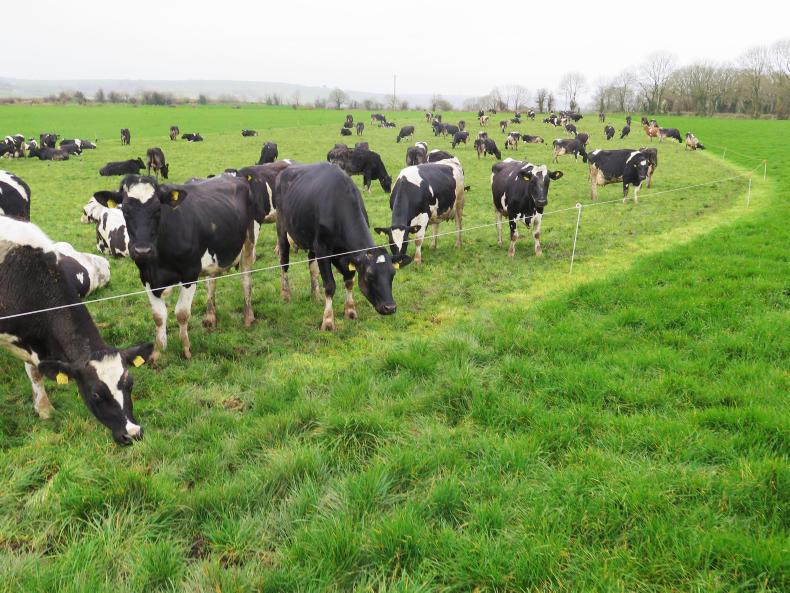

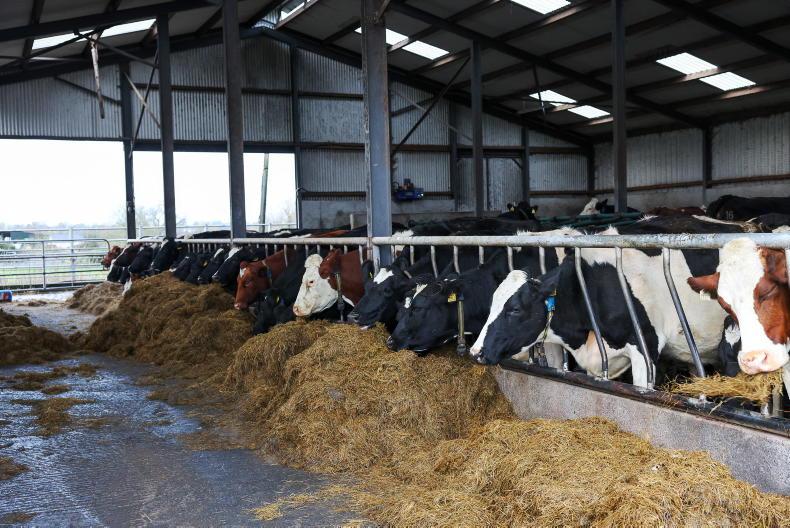
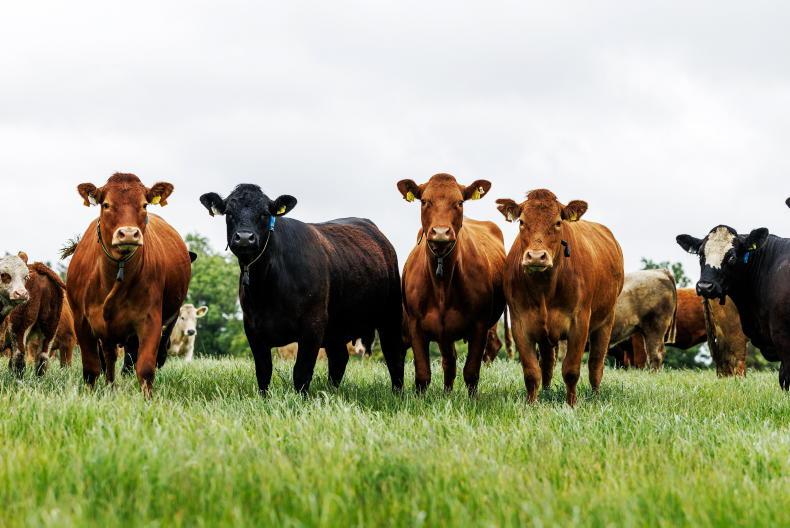
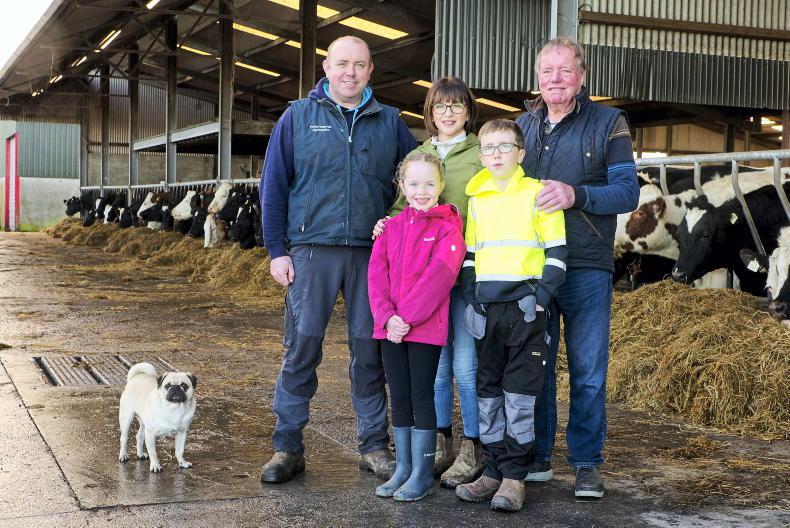
SHARING OPTIONS